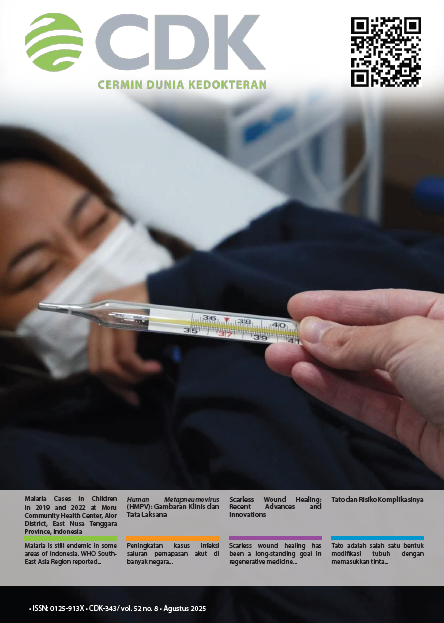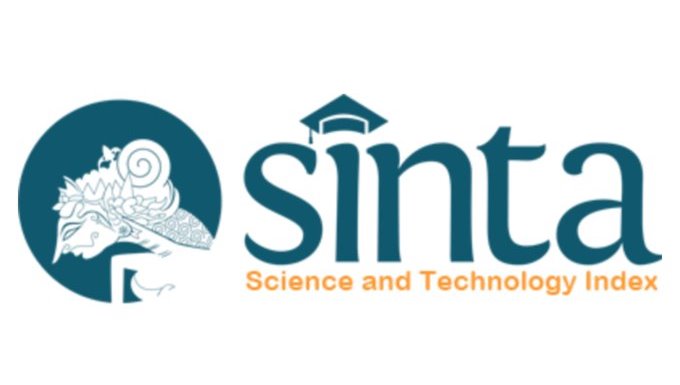Medical, Social, and Policy Perspectives in Understanding Infertility in Indonesia: A Narrative Review
DOI:
https://doi.org/10.55175/cdk.v52i8.1598Keywords:
Indonesia, infertility, public health, reproductiveAbstract
Introduction: Infertility is a reproductive health problem in various countries, including Indonesia, with a significant impact on population and community productivity. This study aims to assess the urgency of addressing infertility in the context of public health and population control in Indonesia. Methods: This research employs a literature review method, referencing relevant sources. Document searches were conducted through Google Scholar and manual searching using the keywords “(Infertility) AND (Indonesia).” Results: The review found 53 literatures consisting of scientific research, medical consensus, review papers, news, and legal products. Discussion: Infertility is a complex problem that requires a multidisciplinary approach. The discussion is organized into several multidisciplinary sections which include a discussion from the medical side in the form of etiology, risk factors, diagnosis flow, and management of infertility, a review of infertility as a public health problem, the impact of infertility on patients and society, sensitive public communication methods regarding infertility, and recommendations for management and policy regulation regarding infertility for government officials. Conclusion: Addressing infertility in Indonesia requires the support of various parties, including the government, health workers, and the community, to overcome its complex impact.
Downloads
References
The Lancet Global Health. Infertility—why the silence? Lancet Glob Health. 2022;10:e773. doi: 10.1016/S2214-109X(22)00215-7.
World Health Organization. Infertility [Internet]. WHO.int. 2023 [cited 2024 Apr 27]. Available from: https://www.who.int/news-room/fact-sheets/ detail/infertility
Carson SA, Kallen AN. Diagnosis and management of infertility: a review. JAMA. 2021;326(1):65–76. doi: 10.1001/jama.2021.4788.
Rochon M. Sterility and infertility: two concepts. Cah Que Demogr. 1986;15(1):27–56. PMID: 12268268.
Leslie SW, Soon-Sutton TL, Khan MA. Male infertility [Internet]. 2024 [cited 2024 Sep 11]. Available from: http://www.ncbi.nlm.nih.gov/books/ NBK562258/.
Thurston L, Abbara A, Dhillo WS. Investigation and management of subfertility. J Clin Pathol. 2019;72(9):579–87. doi: 10.1136/jclinpath-2018-205579.
Gnoth C, Godehardt E, Frank-Herrmann P, Friol K, Tigges J, Freundl G. Definition and prevalence of subfertility and infertility. Hum Reprod. 2005;20(5):1144–7. doi: 10.1093/humrep/deh870.
World Health Organization. 1 in 6 people globally affected by infertility: WHO [Internet]. 2023 [cited 2024 Sep 11]. Available from: https://www. who.int/news/item/04-04-2023-1-in-6-people-globally-affected-by-infertility.
Safitriana. Kemandulan (infertil): stigma negatif pada wanita Indonesia [Internet]. Diryankes Kemenkes RI. 2022 [cited 2024 May 12]. Available from: https://yankes.kemkes.go.id/view_artikel/12/kemandulan-infertil-stigma-negatif-pada-wanita-indonesia.
United Nations. Programme of action adopted at the international conference on population and development, Cairo [Internet]. 1994. Available from: https://www.un.org/development/desa/pd/sites/www.un.org.development.desa.pd/files/files/documents/2020/Jan/un_1995_ programme_of_action_adopted_at_the_international_conference_on_population_and_development_cairo_5-13_sept._1994.pdf.
Fatoni Z, Astuti Y, Situmorang A, Widayatun W. Implementasi kebijakan kesehatan reproduksi di Indonesia: sebelum dan sesudah reformasi. J Kependud Indones. 2015;10:65. doi: http://dx.doi.org/10.14203/jki.v10i1.56.
Merriam JR. Why don’t more public schools teach sex education? a constitutional explanation and critique. William and Mary Journal of Women and the Law 2007:13;539-91.
United Nations Population Fund (UNFPA). International conference on population and development [Internet]. 2024. Available from: https:// www.unfpa.org/icpd.
Banerjee D, Rao TSS. Comprehensive sex education—why should we care? J Psychosexual Health. 2022;4(2):73–5. http://dx.doi. org/10.1177/26318318221092076.
National Health Services. Treatment: infertility [Internet]. 2023 [cited 2024 May 1]. Available from: https://www.nhs.uk/conditions/infertility/ treatment/
Quaas A, Dokras A. Diagnosis and treatment of unexplained infertility. Rev Obstet Gynecol. 2008;1(2):69–76. PMID: 18769664.
Doody KJ. Infertility treatment now and in the future. Obstet Gynecol Clin North Am. 2021;48:801–12. doi: 10.1016/j.ogc.2021.07.005.
Sofiah R, Suhartono S, Hidayah R. Analisis karakteristik sains teknologi masyarakat (STM) sebagai model pembelajaran: sebuah studi literatur. Pedagogi J Penelit Pendidik. 2020;7(1):1-18. doi: 10.25134/pedagogi.v7i1.2611.
Suryoadji KA, Ali N, Sutanto RL, Christian C, Putra ENW, Faruqi M, et al. Kesehatan mental di era digital: tinjauan naratif dampak media sosial dan teknologi digital pada kesehatan mental dan upaya untuk mengatasinya. J Ilm Kesehat. 2024;23(1):46-55. http://dx.doi.org/10.33221/jikes. v23i1.3115.
Vander Borght M, Wyns C. Fertility and infertility: definition and epidemiology. Clin Biochem. 2018;62:2–10. doi: 10.1016/j.clinbiochem.2018.03.012.
Latifah KU. Experience of married couples with infertility: a scoping review. International Conference on Health Practice and Research [Internet]. 2023 [cited 2024 Sep 12]. Available form: https://ojs.stikestelogorejo.ac.id/index.php/ichpr/article/view/365.
ASEAN Secretariat. ASEAN key figures 2023. Jakarta: The Association of Southeast Asian Nations; 2023.
Agustina D, Budihastuti UR, Murti B. Biopsychosocial Factors on infertility among men in Surakarta, Central Java. Indones J Med. 2018;3(1):14–21. https://doi.org/10.26911/theijmed.2018.3.1.92.
Wiweko B, Mansyur E, Yuningsih T, Sini I, Silvana V, Maidarti M, et al. Ten years of in vitro fertilization in Indonesia: access to infertility care in a developing country. Int J Gynaecol Obstet. 2024;165(3):1144–50. doi: 10.1002/ijgo.15322.
Nik Hazlina NH, Norhayati MN, Shaiful Bahari I, Nik Muhammad Arif NA. Worldwide prevalence, risk factors and psychological impact of infertility among women: a systematic review and meta-analysis. BMJ Open. 2022;12(3):e057132. doi: 10.1136/bmjopen-2021-057132.
Moridi A, Roozbeh N, Yaghoobi H, Soltani S, Dashti S, Shahrahmani N, et al. Etiology and risk factors associated with infertility. Int J Womens Health Reprod Sci. 2019;7:346–53. doi: 10.15296/ijwhr.2019.57.
Cena H, Chiovato L, Nappi RE. Obesity, polycystic ovary syndrome, and infertility: a new avenue for GLP-1 receptor agonists. J Clin Endocrinol Metab. 2020;105(8):e2695–709. doi: 10.1210/clinem/dgaa285.
Amanvermez R, Tosun M. An update on ovarian aging and ovarian reserve tests. Int J Fertil Steril. 2016;9(4):411–5. doi: 10.22074/ijfs.2015.4591.
Sabarre KA, Khan Z, Whitten AN, Remes O, Phillips KP. A qualitative study of Ottawa university students’ awareness, knowledge and perceptions of infertility, infertility risk factors and assisted reproductive technologies (ART). Reprod Health. 2013;10:41. doi: 10.1186/1742-4755-10-41
Masoumi SZ, Parsa P, Darvish N, Mokhtari S, Yavangi M, Roshanaei G. An epidemiologic survey on the causes of infertility in patients referred to infertility center in Fatemieh Hospital in Hamadan. Iran J Reprod Med. 2015;13:513–6. PMID: 26568755.
Dai RL, Hou Y, Li FB, Yue JM, Xi Q, Liu RZ. Varicocele and male infertility in Northeast China: Y chromosome microdeletion as an underlying cause. Genet Mol Res. 2015;14(2):6583–90. doi: 10.4238/2015.June.12.13.
Sarvari A, Naderi MM, Heidari M, Zarnani AH, Jeddi-Tehrani M, Sadeghi MR, et al. Effect of environmental risk factors on human fertility. J Reprod Infertil. 2010;11(4):211–25.
Hendarto A, Wiweko B, Santoso B, Harzif AK. Konsensus penanganan infertilitas. Jakarta: Himpunan Endokrinologi Reproduksi dan Fertilitas Indonesia (HIFERI) – Perkumpulan Obstetri dan Ginekologi Indonesia (POGI); 2019.
National Collaborating Centre for Women’s and Children’s Health (UK). Fertility: assessment and treatment for people with fertility problems. London (UK): RCOG Press; 2004. PMID: 25340218.
Minhas S, Bettocchi C, Boeri L, Capogrosso P, Carvalho J, Cilesiz NC, et al. European Association of Urology Guidelines on male sexual and reproductive health: 2021 update on male infertility. Eur Urol. 2021;80:603–20. doi: 10.1016/j.eururo.2021.08.014.
Bjorndahl L, Kvist U. Sequence of ejaculation affects the spermatozoon as a carrier and its message. Reprod Biomed Online. 2003;7(4):440–8. doi: 10.1016/s1472-6483(10)61888-3.
Cunha A, Povoa AM. Infertility management in women with polycystic ovary syndrome: a review. Porto Biomed J. 2021;6(1):e116. doi: 10.1097/j. pbj.0000000000000116.
Penzias A, Bendikson K, Falcone T, Hansen K, Hill M, Jindal S, et al. Evidence-based treatments for couples with unexplained infertility: a guideline. Fertil Steril. 2020;113(2):305–22. doi: 10.1016/j.fertnstert.2019.10.014.
Taebi M, Kariman N, Montazeri A, Majd HA. Infertility stigma: a qualitative study on feelings and experiences of infertile women. Int J Fertil Steril. 2021;15(3):189–96. doi: 10.22074/IJFS.2021.139093.1039.
Jing X, Gu W, Zhang L, Miao R, Xu X, Wang M, et al. Coping strategies mediate the association between stigma and fertility quality of life in infertile women undergoing in vitro fertilization-embryo transfer. BMC Womens Health 2021;21(1):386. doi: 10.1186/s12905-021-01525-9.
Capik A, Aksoy M, Yilmaz E, Yilmaz F. Infertility stigma scale: a psychometric study in a Turkish sample. Perspect Psychiatr Care. 2019;55(2):328–35. doi: 10.1111/ppc.12360.
Aghakhani N, Ewalds-Kvist SB, Sheikhan F, Khoei M. Iranian women’s experiences of infertility: a qualitative study. Int J Reprod Biomed. 2020;18(1):65-
doi: 10.18502/ijrm.v18i1.6203.
Patel A, Sharma PSVN, Kumar P, Binu VS. Sociocultural determinants of infertility stress in patients undergoing fertility treatments. J Hum Reprod Sci. 2018;11(2):172–9. doi: 10.4103/jhrs.JHRS_134_17.
Ofosu-Budu D, Hanninen V. Explanations for infertility: the case of women in rural Ghana. Afr J Reprod Health. 2021;25(4):142-52. doi: 10.29063/ ajrh2021/v25i4.15.
Aitken RJ. The global decline in human fertility: the post-transition trap hypothesis. Life 2024;14(3):369. doi: 10.3390/life14030369.
Lee R, Mason A, Amporfu E, Chong BA, Bixby LR, Bravo J, et al. Is low fertility really a problem? population aging, dependency, and consumption. Science 2014;346(6206):229–34. doi: 10.1126/science.1250542.
Shah PK, Gher JM. Human rights approaches to reducing infertility. Int J Gynaecol Obstet. 2023;162(1):368-74. doi: 10.1002/ijgo.14878.
Hasanpoor-Azghady SB, Simbar M, Vedadhir AA, Azin SA, Amiri-Farahani L. The social construction of infertility among Iranian infertile women: a qualitative study. J Reprod Infertil. 2019;20:178–90. PMID: 31423421.
Harzif AK, Santawi VPA, Wijaya S. Discrepancy in perception of infertility and attitude towards treatment options: Indonesian urban and rural area.
Reprod Health. 2019;16:126. doi: 10.1186/s12978-019-0792-8.
Mumtaz Z, Shahid U, Levay A. Understanding the impact of gendered roles on the experiences of infertility amongst men and women in Punjab. Reprod Health. 2013;10:3. doi: 10.1186/1742-4755-10-3.
Assaysh-Oberg S, Borneskog C, Ternstrom E. Women’s experience of infertility & treatment - a silent grief and failed care and support. Sex Reprod Healthc. 2023;37:100879. doi: 10.1016/j.srhc.2023.100879.
Gerrits T, Kroes H, Russell S, van Rooij F. Breaking the silence around infertility: a scoping review of interventions addressing infertility-related gendered stigmatisation in low- and middle-income countries. Sex Reprod Health Matters. 2023;31(1):2134629. doi: 10.1080/26410397.2022.2134629.
Palmer-Wackerly AL, Voorhees HL, D’Souza S, Weeks E. Infertility patient-provider communication and (dis)continuity of care: an exploration of illness identity transitions. Patient Educ Couns. 2019;102(4):804–9. doi: 10.1016/j.pec.2018.12.003.
Kementerian Kesehatan. Peraturan Menteri Kesehatan No. 43 Tahun 2015 tentang Penyelenggaraan Pelayanan Reproduksi dengan Bantuan atau Kehamilan di Luar Cara Alamiah. Jakarta: Kementerian Kesehatan Republik Indonesia; 2015.
Kementerian Kesehatan. Peraturan Menteri Kesehatan No. 39 Tahun 2010 tentang Penyelenggaraan Pelayanan Teknologi Reproduksi Berbantu. Jakarta: Kementerian Kesehatan Republik Indonesia; 2010.
Universitas 17 Agustus Semarang. Pemerintah perlu meningkatkan pelayanan bayi tabung [Internet]. 2022 [cited 2024 Jul 1]. Available from: https://mail.untagsmg.ac.id/index.php/8-kegiatan-akademik/223-pemerintah-perlu-meningkatkan-pelayanan-bayi-tabung.
Tay ZL, Hsieh ZH. In-vitro fertilisation laws and regulations. Kuala Lumpur: ZICO law; 2021.
The Economist Intelligence Unit. The disappearing workforce? Why countries in Southeast Asia need to think about fertility rates before it’s too late. London: The Economist; 2019.
Association of Southeast Asian Nations. Maternity protection for female workers: Laws and practices in ASEAN. Jakarta: ASEAN Secretariat; 2015.
Myanmar has longest maternity leave in Southeast Asia. Naypydaw: Myanmar Ministry of Information; 2018.
United Nations Population Fund Thailand. The State of Thailand’s Population Report 2015. Bangkok: United Nations Population Fund Thailand; 2015.
Vietnam Government. Social Insurance law No. 58/2014/QH13. Hanoi: The Socialist Republic of Vietnam; 2014.
Dewan Perwakilan Rakyat Republik Indonesia. Undang-Undang No. 4 Tahun 2024 tentang Kesejahteraan Ibu dan Anak. Jakarta: Dewan Perwakilan Rakyat Republik Indonesia; 2024.
Enhanced Baby Bonus. Singapore: Ministry of Social and Family Development; 2017.
Selangor Children Heritage Foundation. About TAWAS. Selangor: Selangor Children Heritage Foundation; 2018.
iSejahtera: Program Anak Emas. Penang: Penang State Secretariat Office; 2018.
LPPKN. Population and Family Policies in Malaysia. Kuala Lumpur: LPPKN Malaysia; 2014.
Ministry of Health Singapore. Marriage and Parenthood Schemes [Internet]. 2024. Available from: https://www.moh.gov.sg/healthcare-schemes- subsidies/marriage-and-parenthood-schemes.
Intan G. Kendalikan jumlah penduduk, BKKBN gencarkan program vasektomi gratis dengan insentif uang Jakarta: Voice of America Indonesia. VOA Indonesia [Internet]. 2024 [cited 2024 Jul 1]. Available from: https://www.voaindonesia.com/a/kendalikan-jumlah-penduduk-bkkbn-gencarkan- program-vasektomi-gratis-dengan-insentif-uang/7613384.html.
Fauziah TA. Angka kelahiran menurun drastis, BKKBN targetkan pasangan lahirkan satu anak perempuan. Kompas [Internet]. 2024 [cited 2024 Jul 1]. Available from: https://regional.kompas.com/read/2024/06/29/060000978/angka-kelahiran-menurun-drastis-bkkbn-targetkan-satu- pasangan-lahirkan-satu.
Downloads
Published
How to Cite
Issue
Section
License
Copyright (c) 2025 Reynardi Larope Sutanto, Rizki Fauzi Suskhan, Satria Arief Pratama, Christopher Christian, Elza Nur Warsa Putra, Muhammad Faruqi, Kevin Tadeus Simanjuntak, Najma Ali, Dhanis Adrianto Setyawan, Kemal Akbar Suryoadji

This work is licensed under a Creative Commons Attribution-NonCommercial 4.0 International License.





















